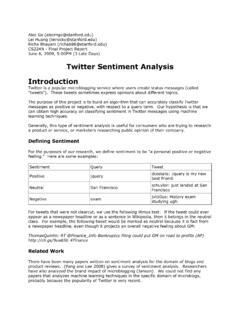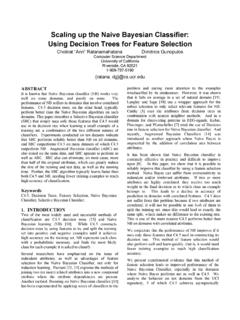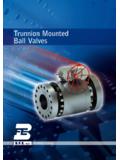Transcription of SystemC - Donald Pederson
1 SystemCTutorialJohn MoondanosStrategic CAD Labs, INTEL Visiting Fellow, UC BerkeleySystemCIntroduction Why not leverage experience of C/C++ developers for H/W & System Level Design? But C/C++ have no notion of time No event sequencing Concurrency But H/W is inherently concurrent H/W Data Types No Z value for tri-state busesSystemCis .. C++ class Library use for Cycle-Accurate model for Software Algorithm Hardware Architecture Interface of SoC(System-on-Chip) System-level designs Executable Specification Provide VHDL like capabilities Simulation kernel Fixed point arithmetic data types Signals (communication channels) Modules Break down designs into smaller partsSystemCHistory Complete library rewrite to upgrade into true SLDL Events as primitive behavior triggers Channels, Interfaces and Ports Much more powerful modeling for Transaction Level Future Modeling of OSs Support of embedded S/W modelsObjectives of Primary goal: Enable System-Level Modeling Systems include hardware and software Challenge.
2 Wide range of design models of computation Wide range of design abstraction levels Wide range of design Objectives (cont) Introduces a small but very general purpose modeling foundation => Core Language Support for other models of computation, methodologies, etc They are built on top of the core language, hence are separate from it Even Signalsare built on top of this core in Other library models are provided: FIFO, Timers, ..Communication and Synchronization Modulesand Processesare still useful in system design But communication and synchronization mechanisms in (Signals) are restrictive for system-level modeling Communication using queues Synchronization (access to shared data) using mutexesSystemCLanguage ArchitectureCore SystemSystemCvs.
3 Metropolis Constructs to model system architecture Hardware timing Concurrency Structure Adding these constructs to C SystemC C++ class library Standard C/C++ Compiler : bcc, msvc, gcc, Metropolis New keywords & Syntax Translator for SystemC Many More Design Methodology Current Manual Conversionfrom C to HDL Creates Errors Disconnect Between System Model and HDL Model Multiple System Tests SystemC (Executable-Specification) Refinement Methodology Written in a Single LanguageModeling Terms (I) UntimedFunctional (UTF) Refers to model I/F and functionality No time used for regulating the execution Execution & data transport in 0 time Timed Functional (TF) Refers to both model I/F and functionality Time is used for the execution Latencies are modeled Data Transport takes timeModeling Terms (II) Bus Cycle Accurate (BCA)
4 Refers to model I/F, not functionality Timing is cycle accurate, tied to some global clock Does not infer pin level detail Transactions for data transport Pin Cycle Accurate (PCA) Refers to model I/F not model functionality Timing is cycle accurate Accuracy of the I/F at the pin Level Register Transfer (RT) Accurate Refers to model functionality Everything fully timed Complete detailed Description, every bus, every bit is modeledModel Types (1) System Architectural Executable specification for H/W & S/W Architecture Exploration, algorithm determination & proof I/Fs are UTF with no pin detail for modeling communication protocols Functionality UTF, sequential since it s untimed System Performance Timed executable specification for bithH/W & S/W Used for time budgeting Concurrent behavior modeled Transaction Level (TLM) Typically describe H/W only Model I/Fs are TF, functionality TF as well (either not cycle accurate) Data Transfers & system Behavior modeled as transactionsModel Types (2)
5 Functional Model Above TLM, System Architectural & System Performance System Level Above RTL Behavioral Synthesis Architectural Analysis & Implementation I/F cycle accurate with pin level detail Functionality TF and not cycle accurate Bus Functional Model (BFM) Used for simulation (mainly of processors) Not meant for synthesis I/F pin cycle accurate Transactions for functionality Register Transfer Level (RTL) Verilog, VHDL Gate Level not good in SystemCCurrent MethodologyC/C++System Level ModelAnalysisResultRefineVHDL/VerilogSim ulationSynthesis- Manual Conversion Creates Errors- Disconnect Between System Model and HDL Model- Multiple System TestsSystemCMethodologyUsing Executable Specifications Ensure COMPLETENESS of Specification Create a program that Behave the same way as the system UNAMBIGUOUS Interpretation of the Specification Validate system functionality before implementation Create early model and Validate system performance Refine and Test the implementation of the SpecificationSystemCand User ModuleExecutable SpecificationExecutable SpecificationSystemCSystemCHardware Simulation Kernel(Event Scheduler)
6 C++ class LibraryUserModule#1 UserModule#1 UserModule#2 UserModule#2 UserModule#NUserModule# & Signal I/FEventsSystemCHighlights (1) introduces general-purpose Events Flexible, low-level synchronization primitive Used to construct other forms of synchronization Channels A container class for communication and synchronization They implement one or more interfaces Interfaces Specify a set of access methods to the channel Other comm& sync models can be built based on the above primitives Examples HW-signals, queues (FIFO, LIFO, message queues, etc) semaphores, memories and busses (both at RTL and transaction-based models)SystemCHighlights (2) Support Hardware-Software Co-Design All constructs are in a C++ environment Modules Container class includes hierarchical Modules and Processes Processes Describe functionality Almost all SLDL have been developed based on some underlying model of network of processes Ports Single-directional(in, out), Bi-directional modeA system in SystemCA system in SystemCSystemCHighlights (3) Constructs in a C++ environment (continued)
7 Clocks Special signal, Timekeeper of simulation and Multiple clocks, with arbitrary phase relationship Event Driven simulation High-SpeedEventDriven simulation kernel Multiple abstraction levels Untimedfrom high-level functional model to detailed clock cycle accuracy RTL model Communication Protocols Debugging Supports Run-Time error check Waveform Tracing Supports VCD, WIF, ISBDData Types SystemCsupports Native C/C++ Types SystemCTypes SystemCTypes Data type for system modeling 2 value ( 0 , 1 )logic/logic vector 4 value ( 0 , 1 , Z , X )logic/logic vector Arbitrary sized integer (Signed/Unsigned) Fixed Point types (Templated/Untemplated)Communication and Synchronization (cont d)ChannelModule1 Module2 EventsInterfacesPorts to InterfacesA Communication Modeling Example: FIFOFIFOP roducerConsumerWrite InterfaceRead InterfaceFIFO Example:Declaration of Interfacesclass write_if: public sc_interface{public:virtual void write(char) = 0;virtual void reset() = 0;}; class read_if: public sc_interface{public:virtual void read(char virtual intnum_available() = 0;};FIFOpcDeclaration of FIFO channelFIFO pcclass fifo: public sc_channel,public write_if,public read_if{private:enume {max_elements=10};char data[max_elements];intnum_elements, first;sc_eventwrite_event,read_event;boo lfifo_empty() {.)}}
8 };boolfifo_full() {..};public:fifo() : num_elements(0), first(0);void write(charc) {if (fifo_full())wait(read_event);data[ <you calculate>] = c;++num_elements; ();}void read(char&c) {if (fifo_empty())wait(write_event);c = data[first];--num_elements;first = ..; ();}Declaration of FIFO channel(cont d)FIFO pcvoid reset() { num_elements= first = 0;}intnum_available() {return num_elements;}};// end of class declarationsFIFO Example (cont d) Any channelmust be derived from sc_channelclass be derived from one (or more) classes derived from sc_interface provide implementations for all pure virtual functions defined in its parent interfacesFIFO Example (cont d) Note the following wait() call wait(sc_event) => dynamic sensitivity wait(time) wait(time_out, sc_event) Events are the fundamental synchronization primitive have no type, no value always cause sensitive processes to be resumed can be specified to occur: immediately/ one delta-step later/ some specific time laterCompleting the Comm.
9 Modeling ExampleFIFOpcSC_MODULE(producer) {public:sc_port<write_if>out;SC_CTOR(producer) {SC_THREAD(main);}void main() {char c;while (true) { (c);if(..) ();}}};SC_MODULE(consumer) {public:sc_port<read_if>in;SC_CTOR(consumer) {SC_THREAD(main);}void main() {char c;while (true) { (c);cout<< ();}}};Completing the Comm. Modeling Example (cont d)FIFOpcSC_MODULE(top) {public:fifoafifo;producer *pproducer;consumer *pconsumer;SC_CTOR(top) {pproducer=new producer( Producer );pproducer->out(afifo);pconsumer=new consumer( Consumer );pconsumer->in(afifo);};Completing the Comm. Modeling Example (cont d) Note: Producer module sc_port<write_if> out; Producer can only call member functions of write_ifinterface Consumer module sc_port<read_if> in; Consumer can only call member functions of read_ifinterface Producer and consumer are unaware of how the channel works just aware of their respective interfaces Channel implementation is hidden from communicating modulesCompleting the Comm.}
10 Modeling Example (cont d) Advantages of separating communication from functionality Trying different communication modules Refine the FIFO into a software implementation Using queuing mechanisms of the underlying RTOS Refine the FIFO into a hardware implementation Channels can contain other channels and modules Instantiate the hw FIFO module within FIFO channel Implement read and write interface methods to properly work with the hw FIFO Refine read and write interface methods by inliningthem into producer and consumer codesSystemCrefinementSystemCChannel ReplacementSystemCAdapter InsertionSystemCAdapter MergeSystemCscheduler Like most modeling languages SystemChas a simulation kernel, too Event Based Simulation for modeling concurrency Processes executed & their outputs updated based on events Processes are scheduled based on their sensitivity to events Similarity with key VHDL simulation kernel aspects is evidentSystemC& VHDL SimilaritiesSC_THREAD(proc_1); sensitive << ( );SC_THREAD(proc_2);sensitive << ( ); Which process should go first?










